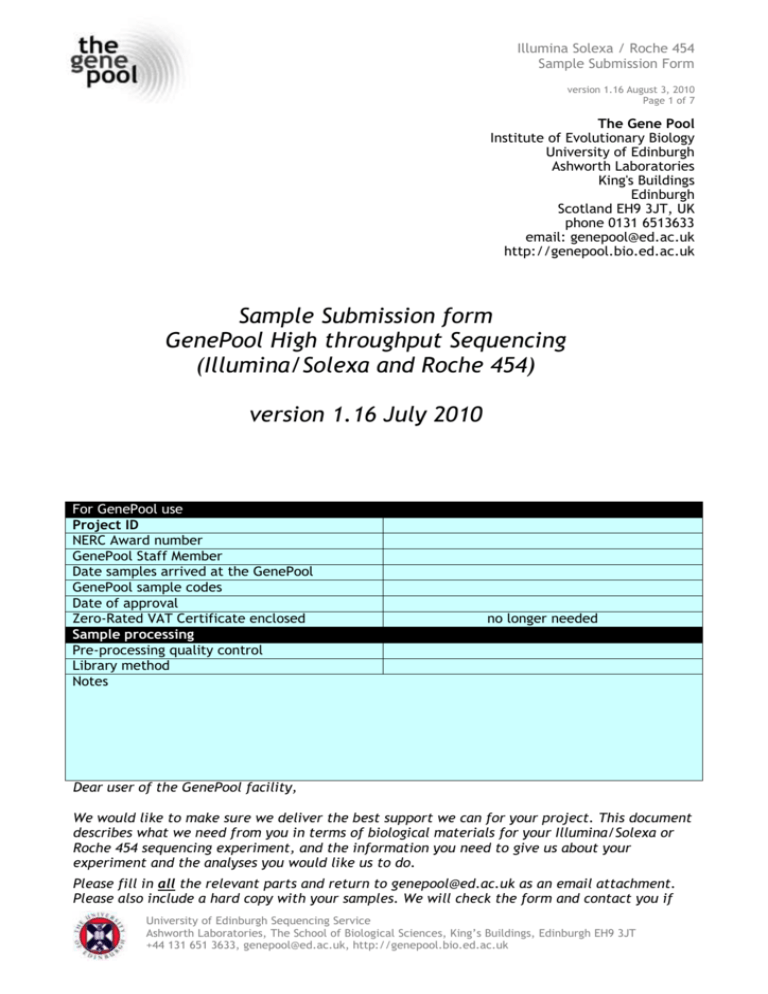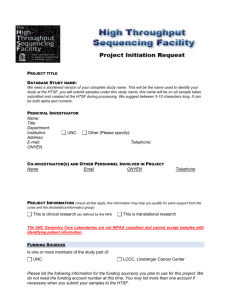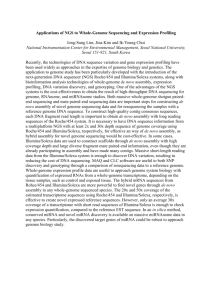Sample Submission Form for 454 and Illumina
advertisement

Illumina Solexa / Roche 454 Sample Submission Form version 1.16 August 3, 2010 Page 1 of 7 The Gene Pool Institute of Evolutionary Biology University of Edinburgh Ashworth Laboratories King's Buildings Edinburgh Scotland EH9 3JT, UK phone 0131 6513633 email: genepool@ed.ac.uk http://genepool.bio.ed.ac.uk Sample Submission form GenePool High throughput Sequencing (Illumina/Solexa and Roche 454) version 1.16 July 2010 For GenePool use Project ID NERC Award number GenePool Staff Member Date samples arrived at the GenePool GenePool sample codes Date of approval Zero-Rated VAT Certificate enclosed Sample processing Pre-processing quality control Library method Notes no longer needed Dear user of the GenePool facility, We would like to make sure we deliver the best support we can for your project. This document describes what we need from you in terms of biological materials for your Illumina/Solexa or Roche 454 sequencing experiment, and the information you need to give us about your experiment and the analyses you would like us to do. Please fill in all the relevant parts and return to genepool@ed.ac.uk as an email attachment. Please also include a hard copy with your samples. We will check the form and contact you if University of Edinburgh Sequencing Service Ashworth Laboratories, The School of Biological Sciences, King’s Buildings, Edinburgh EH9 3JT +44 131 651 3633, genepool@ed.ac.uk, http://genepool.bio.ed.ac.uk Illumina Solexa / Roche 454 Sample Submission Form version 1.16 August 3, 2010 Page 2 of 7 we are missing any information necessary to process your samples (please note that this may delay the start of your project). The blue segments are for the GenePool’s own records. We strongly recommend that you send us quality control data for your samples before submitting your samples. Our technologists will be happy to advise on the suitability of your samples for sequencing. Karim Gharbi and the GenePool team Delivering samples to the GenePool Please deliver DNA and RNA samples frozen on dry ice wherever possible. For large insert bacterial or other clones you can supply a stab culture. The amount of nucleic acid we need differs depending on the kind of sequencing we are going to perform. While we may be able to do with ~50% of the amounts quoted below, it is best if you send us at least these amounts, as it acts as insurance in case of technical failure. We will check all samples for purity and integrity before processing and will contact you if we think there are issues. Genome resequencing using Solexa or 454 Please send us at least 5 µg of clean genomic DNA, free of contaminating RNA (10 µg if quantified by a NanoDrop spectrophomoter). The power of the sequencing platforms means that analyses can cope with low levels of DNA from contaminants but it is best to ensure that the sample is pure. Sequencing of PCR products Please send us at least 5 µg of clean DNA, with the different PCRs already mixed in equimolar ratios (10 µg if quantified by a NanoDrop spectrophomoter). Genome de novo sequencing using Solexa or 454 Please send us at least 5 µg of clean genomic DNA, free of contaminating RNA (10 µg if quantified by a NanoDrop spectrophomoter). The power of the sequencing platforms means that de novo assembly can cope with very low levels of DNA from contaminants but it is best to ensure that the sample is 99.9% pure. If you would like us to make large-insert mate-pair libraries as part of your project, we require at least 20 µg of high molecular weight DNA (40 µg if quantified by a NanoDrop spectrophomoter). Chromatin immunoprecipitate / nucleosome phasing sequencing This is best performed with Illumina/solexa sequencing. Please supply as much DNA as possible. As the starting DNA from these technologies is already at the ‘correct’ size for processing for SOLEXA sequencing we can usually proceed directly with users DNA, and require only ~100 ng. Transcriptome sequencing using Solexa or 454 Please supply at least 5 µg of total RNA (10 µg if quantified by a NanoDrop spectrophomoter). Digital transcriptomics using Solexa Please supply at least 5 µg of total RNA (10 µg if quantified by a NanoDrop spectrophomoter). Short RNA sequencing (siRNA, miRNA, piRNA) using Solexa Please supply at least 5 µg of total RNA (10 µg if quantified by a NanoDrop spectrophomoter). YOUR CONTACT INFORMATION Name of Researcher Institution Address Contact telephone number Contact email address Project Principal Investigator (if different from above) Principal Investigator’s email address University of Edinburgh Sequencing Service Ashworth Laboratories, The School of Biological Sciences, King’s Buildings, Edinburgh EH9 3JT +44 131 651 3633, genepool@ed.ac.uk, http://genepool.bio.ed.ac.uk Illumina Solexa / Roche 454 Sample Submission Form version 1.16 August 3, 2010 Page 3 of 7 Date samples sent/delivered QUOTATION Please note here the GenePool quotation number Total amount to be charged as shown on the quote If you have not yet obtained a formal quote from us, please do so (cost estimates given by email are not valid). Contact us at genepool@ed.ac.uk specifying what you want to sequence and what technology you want to use. We will contact you to clarify your requirements and issue a quote. Please note that we cannot process your samples unless we have issued a quote for your experiment. FINANCIAL INFORMATION1 For University of Edinburgh School of Biological Sciences Users Financial codes (both the COST CENTRE and the JOB Cost Centre Job Code or CODE or GRANT NUMBER; available from your local Grant Number accounts office) For other University of Edinburgh Users Electronic internal transfer (eIT) number For NERC-funded Molecular Genetics Facility Users NERC grant award number MGF Application number For other Users (not University of Edinburgh) Purchase order number (or other unique reference) Purchase Order Form2 enclosed faxed (date) VAT Registration Number3 Name of finance/accounts contact person Finance telephone number Finance email address 1 For any queries regarding invoicing, please contact the GenePool's administration team (genepool-admin@ed.ac.uk). 2 Please enclose a copy of the purchase order form or fax to: 0131 651 3629 FAO the GenePool's administration team. The supplier name for purchase orders is 'University of Edinburgh'. Bank and payment details will be given on our invoice and are the same as for all standard invoices issued by the University of Edinburgh. 3 Next-generation sequencing projects carried out by the GenePool are regarded as research collaborations and therefore fall outside the scope of VAT. If you believe your project is liable to VAT please contact the GenePool's administration team to discuss your requirements. SAMPLE INFORMATION Total number of samples We will only start work on your project once we have received all samples How will samples be delivered? Are ethical and other regulatory permissions required (see below) Does the DNA pose a potential bio-hazard? (e.g. a retroviral source)? Type of sample (please tick) 1. Genomic DNA 2. PCR products 3. Amplicons (i.e. PCR products with adapters, ready for sequencing) 4. RNA for transcriptome sequencing 5. Small RNA 6. ChIP DNA University of Edinburgh Sequencing Service Ashworth Laboratories, The School of Biological Sciences, King’s Buildings, Edinburgh EH9 3JT +44 131 651 3633, genepool@ed.ac.uk, http://genepool.bio.ed.ac.uk Illumina Solexa / Roche 454 Sample Submission Form version 1.16 August 3, 2010 Page 4 of 7 7. Large insert clones 8. Other (please specify, e.g. RAD library) 1. SAMPLES SUPPLIED AS GENOMIC DNA FOR DE NOVO SEQUENCING OR RE-SEQUENCING What is the estimated size of the genome (in megabases)? How was this size estimated? GC content (%) DNA preparation method? (e.g. phenol/chloroform or kit name) Has the integrity of the genomic DNA been assessed? If so, how? Has the DNA been RNAse-treated? 2. SAMPLES SUPPLIED AS PCR PRODUCTS Length of the PCR products? (please give a range if they vary) Have the PCR products been cleaned up? If so, how? 3. SAMPLES SUPPLIED AS AMPLICONS Length of amplicons? (please give a range if they vary) Have amplicons been cleaned up? If so, how? 4. RNA SAMPLES FOR WHOLE TRANSCRIPTOME SEQUENCING Sample preparation method? (eg, phenol/chloroform or kit name) Has the integrity of the total RNA been assessed? If so, how? Has the RNA been DNAse-treated (recommended)? 5. RNA SAMPLES FOR SMALL RNA SEQUENCING Has the integrity of the total RNA been assessed? Has the small RNA fraction been isolated? If so, how? Has the RNA been DNAse-treated (recommended)? 6. SAMPLES FOR ChIP-SEQ AND NUCLEOSOME PHASING APPLICATIONS Size (and range) of ChIP enriched DNA Has the DNA been RNAse-treated (recommended)? 7. LARGE INSERT CLONES FOR SEQUENCING What cloning vector is the insert in? What bacterial or yeast host is the clone supplied in? What is the expected or known insert size? DNA preparation method? (e.g. kit name) Has the DNA been RNAse-treated (recommended)? 8. SAMPLES SUPPLIED AS SEQUENCING LIBRARIES What is the expected fragment size? Has the quality of library been assessed? If so, how? University of Edinburgh Sequencing Service Ashworth Laboratories, The School of Biological Sciences, King’s Buildings, Edinburgh EH9 3JT +44 131 651 3633, genepool@ed.ac.uk, http://genepool.bio.ed.ac.uk Illumina Solexa / Roche 454 Sample Submission Form version 1.16 July 26 2010 Page 5 of 7 SAMPLE DATA AND QUALITY CONTROL1 (please add rows as necessary) Sample name2 Organism3 OD 260:280 Concentration (ng/µl) (as labelled on the tube) 1 Volume Total amount (µl) (µg) Quantification Buffer5 method4 GC content (if known) Please provide a gel picture or Bioanalyzer trace for each sample 2 All samples must be distinctly labelled If the source of your samples is human or other organism covered by regulatory controls such as the Human Tissue regulations or CITES regulations we require you to affirm to us that all samples are covered by relevant licences and ethical permissions. You should note that we are not a clinical diagnostic service, and you should not use us as such 3 4 We strongly recommend using a fluorimeter or gel electrophoresis against a known mass standard for quantification of nucleic acids; please supply twice the requested amount of DNA/RNA if quantified using a NanoDrop instrument as we find that NanoDrop concentrations are often grossly over-estimated 5 TE preferred for DNA, ultrapure dH2O preferred for RNA University of Edinburgh Sequencing Service Ashworth Laboratories, The School of Biological Sciences, King’s Buildings, Edinburgh EH9 3JT +44 131 651 3633, genepool@ed.ac.uk, http://genepool.bio.ed.ac.uk Illumina Solexa / Roche 454 Sample Submission Form version 1.16 July 26 2010 Page 6 of 7 SEQUENCING AND BIOINFORMATICS REQUIREMENTS Illumina/Solexa sequencing please specify read length (currently 36, 50, 75, or 100 bases) and number of reads, coverage or megabases of sequence required Single-end sequencing Paired-end sequencing Mate-pair paired-end sequencing (please give desired virtual insert size) 454 Titanium sequencing (please specify number of reads, coverage, or megabases of sequence required) PLEASE PROVIDE A BRIEF NARRATIVE OF YOUR SEQUENCING REQUIREMENTS PLEASE PROVIDE A BRIEF NARRATIVE OF YOUR BIOINFORMATICS REQUIREMENTS ADDITIONAL DETAILS ABOUT YOUR SAMPLES: SPECIAL PROCESSING INSTRUCTIONS, COMMENTS ON KNOWN ISSUES OR FEATURES OF THE SAMPLE OR GENOME, HAZARDS ARISING FROM THE SAMPLES The GenePool, The University of Edinburgh Ashworth Laboratories, The School of Biological Sciences, King’s Buildings, Edinburgh EH9 3JT +44 131 651 3633, genepool@ed.ac.uk, http://genepool.bio.ed.ac.uk Illumina Solexa / Roche 454 Sample Submission Form version 1.16 July 26 2010 Page 7 of 7 Service Delivery Goals: Illumina GAIIx and Roche 454 Titanium In the GenePool we aim to deliver high quality support to our users. We measure the quality of the support we deliver by user satisfaction, and thus aim to meet or exceed user requirements for sequence delivery. Illumina GAII: data volumes On the Illumina SOLEXA GAIIx system we aim to generate at least 12 million single-end reads per lane, or 10 million paired-end reads per lane (there are eight lanes in a flow cell). A GAIIx flow cell lane can deliver up to 20 million reads, but this is sometimes at the cost of overall read quality. We will sometimes seed lanes at low densities for titration and other operational reasons, but will deliver at least the number of reads or coverage specified in our quote. Roche 454 Titanium: data volumes The Titanium version of the instrument and reagents delivers up to 800,000 reads of average length 350450 bases per run. We offer part-run volumes to users, but these are at the price of fewer reads overall (e.g. an eighth of a run generates ~80,000 reads). Sequencing project timing The GenePool delivers sequencing to hundreds of users across the UK, and our order book is usually ‘full’. We make strategic investments in staff and instruments to ensure that our sequencers are running as fast as we can make them. Our Technologists will be able to advise you on the length of time the current queue represents. Samples are regarded as being in the queue when they are delivered and we have confirmed that they are suitable for sequencing after quality control. Please note that we do not ‘book space’ for samples in advance. The preparation, sequencing and bioinformatics processing of samples take time. The workflow of the process has also to be scheduled with respect to instrument capacity, staff availability and the queue of user samples. On receipt of your sample with a completed samples submission form, we will email the designated contact person to acknowledge receipt and to give a first estimate of when the sample will be processed (i.e. its place in the queue). The Illumina GAIIx workflow: Library preparation for the Illumina GAIIx takes from 3 to 5 working days; multiple samples can be prepared at one time, but large sample sets may take several weeks to process. The run time on the GAIIx sequencer is up to 4 working days for a single-end run, and for a paired-end run up to 10 working days. Basic bioinformatics processing takes 2 to 3 working days depending on sample type. Thus from initiating the processing of a single sample, it will be at least 10 working days before preliminary results are available. We will email the designated contact person when the samples are loaded onto the sequencing instrument to keep you informed of progress. If the run or the sample has performed below our stringent quality criteria, we will inform the designated contact person, and (usually) re-sequence the sample (at no extra cost to the user) on the next available sequencer run. The Roche 454 Titanium workflow: Preparation of sequencing libraries for the Roche 454 can take from 3 working days (genomic DNA samples) to six weeks (RNA samples for generation of normalised cDNA). The sequencing process takes at least a week, including titration and QC steps. Bioinformatics workflow: Once high quality data are generated, we will perform the basic bioinformatics processing required. If the user has requested additional intensive bioinformatics analyses, we will provide the user with an estimate of the timeframe for completion of these tasks. If users have any questions about timing or quality of service they should in the first instance contact me. Mark Blaxter August 3rd, 2010 The GenePool, The University of Edinburgh Ashworth Laboratories, The School of Biological Sciences, King’s Buildings, Edinburgh EH9 3JT +44 131 651 3633, genepool@ed.ac.uk, http://genepool.bio.ed.ac.uk






